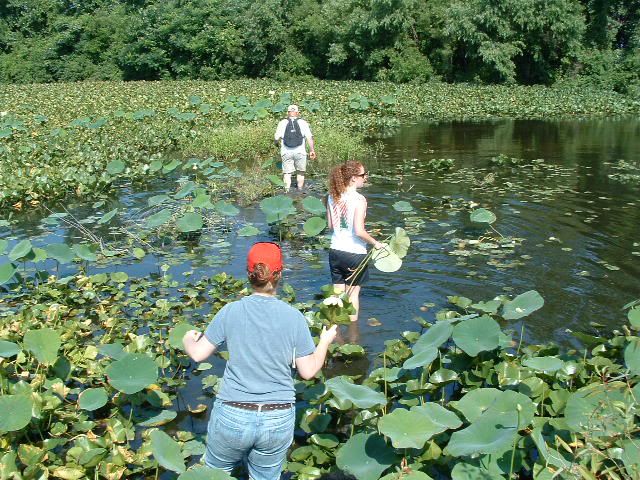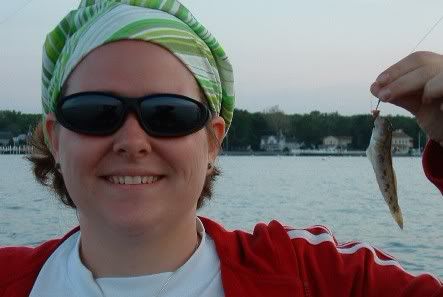Let loose the mad-dogs of flora!

After two languid days of swimming, visiting Put-In-Bay's Christmas in July, and volleyball (oh, yes, and studying) we jumped right back into things Monday heading over to Middle Bass Island.
Backtracking just a smidge, my roommate had been out swimming this past weekend and she found an interesting clump of plants that looked an awful lot like wild onions, but underwater. She brought them in for inspection and Dr. Moore told her to hang on to them. Monday morning, he made a mention of these plants and we all looked at the unsuspecting looking things and headed out. Well, almost as soon as we got off the boat at Middle Bass, Dr. Moore dragged us over to a muddy patch of ground and pointed out the Flowering-Rush (Butomous Umbellatus). Well, it turns out that this is the same plant as what my roomie saw! Apparently, it has amphibious qualities but is sterile underwater. In other words, it doesn't flower submerged. How cool is that? He then told us about another plant called Water Star-Grass (Zosterella dubia) that grows long and flaccid in the water but, if on land, it'll grow in a small grassy clump. We have the aquatic "version" of that in our collections already.
We then piled into the van and headed over to Kuehnle Wildlife Area (I had been here before with my Local Flora class) and we tromped up and down the road for a bit looking at what goodies were in the ditches. We found Blue-Joint Grass (Calamagrostis canadensis) and Willow-Herb (Epilobium hirsutum). Dr. Moore also showed us Mad-Dog Skullcap (Scutellaria lateriflora) and Sand Bar Willow (Salix exigua). We even found some awsomely huge Bulrush (Scirpus atrovirens) which isn't a rush at all, it's a sedge.
After looking at those (and many more) and collecting samples for our herbariums we headed on down to the other end of Haunks Pond to check out the lilies.

We already got the White Water Lilies on Friday and today's prey was the American Lotus (Nelumbo lutea). It has these HUGE leaves, easily 12+ inches across on some. Plus, as a nifty educational bonus, they have peltate leaves, meaning the leaves are round with the stem attached in the middle, on the underside. Nastutium has them too. Along the way, we had a pleasant surprise in the Spadderdock (aka Cow Lily or Nuphar lutea). I also got surprised by a large dead carp, but since I didn't have my camera with me then, I'll spare you.
Needless to say, by the time we got out of there, my shoes were no longer white. (Please see picture above.) I briefly got to see the Bald Eagle that lives there but, per usual, it was not in a good place to take a picture. Perhaps I'll get lucky at Kellys Island this time.
Later that afternoon, once we got back with our treasures, we learned more about plants in general. We got these great handouts on what the Latin means in the taxonomy and a pronunciation guide. Who'd have thought I'd actually be happy to learn Latin?
That evening, after a brief siesta, I decided to take a liesurely row around the island. Of course, I forgot to bring my camera so I missed out on a very pretty sunset and a perfectly perched Swallow amongst other things. I'll make up for that. My liesurely row ended up not being so liesurely since I decided to make it a collecting trip. Not only was I fishing for weeds but I ended up doing a rowboat obstical course around all the islets around Gibraltar. It was fun and I found some cool stuff.
Today was nice and liesurely too. That's the nice thing about taking one full term class at a time. You get days off to swim (and/or collect plants like we did today), go fishing, check out the sites, or just nap. It's like a vacation where you learn stuff. :)


0 Comments:
Post a Comment
<< Home